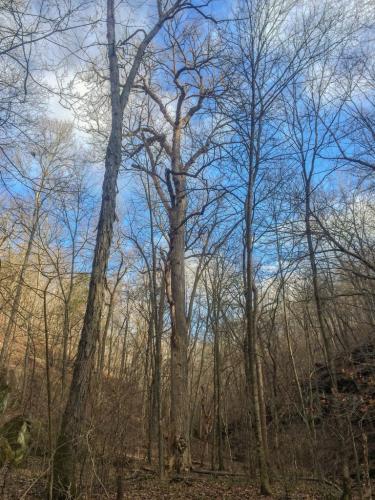
Xplor reconnects kids to nature and helps them find adventure in their own backyard. Free to residents of Missouri.


































Stay in Touch with MDC news, newsletters, events, and manage your subscription

Xplor reconnects kids to nature and helps them find adventure in their own backyard. Free to residents of Missouri.

A monthly publication about conservation in Missouri. Started in 1938, the printed magazine is free to residents of Missouri.




St. Louis, Mo. — As fall slips upon us and hidden colors of yellow, red, orange, and purple begin to emerge, autumn is the perfect time to turn our attention to trees. The State Champion Tree Program administered by the Missouri Department of Conservation (MDC) recognizes Missouri's largest native trees by species.
MDC recently added two trees in the St. Louis region to that distinguished list:
The St. Louis area is fortunate enough to now boast 24 champion trees in all — approximately one out of five of the total state champion trees found in all of Missouri.
Missouri's champion trees are selected based on a formula which gives the tree a point value. Points are determined by a tree's height, crown spread and trunk size. The formula adds the circumference in inches (measured at a point 4.5 feet above the ground) to the height in feet, to one-fourth of the average crown spread.
MDC awards official plaques of recognition to both the nominator and the owner of a champion tree.
The new state champion black willow (Salix nigra) is located on MDC's Pacific Palisades Conservation Area in St. Louis County. Pacific Palisades lies on the Meramec River and the tree is visible from the river. The champion black willow measures 79 inches in circumference, 95 feet high, and has a spread of 42 feet, giving the tree a total of 185 points.
The largest and most widely known of our native willows, the black willow is the only member of the willow family that reaches commercial size. It is a medium to large-sized tree with a straight trunk and a broadly irregular, open crown when growing on good sites. It is common throughout the state and typically grows along waterways such as streams, swamps, sloughs, marshes, and ponds in wet bottomland soils. Black willows are very tolerant of flooding for long periods, and can withstand being buried by sediments that accompany floods. It grows rapidly, but is short lived — usually less than 85 years. It is one of the largest willow species in the world, reaching up to 120 feet in the southern United States. Before plastics, toys were made from willow.
The new state champion slippery elm (Ulmus rubra) was discovered on private property off Lost Creek Road in Warren County. Measurements for the new champion slippery elm are 132 inches in circumference and 104 feet high, with a spread of 53 feet. The tree's total point value is 249.
Except for scattered counties in the Ozarks, slippery elm is found in almost every county in the state. It is a medium-sized tree with a long trunk dividing into large branches that form a spreading, open, flat-topped crown. The tree occurs in dry upland or rocky woods and along streams. Slippery elm is a water-loving tree and reaches its largest size on moist, rich soils on lower slopes, stream banks, river terraces and bottomlands. Tea from the inner bark was used by Native Americans and settlers for ailments including sore throats, coughs, stomach ulcers and upset stomach, and for treating external wounds.
State champion trees are often discovered and nominated by members of the public. MDC recommends that if a person feels they may know a possible candidate they should first correctly identify the tree and measure the trunk as previously described.
They can then go to mdc.mo.gov/discover-nature/outdoor-recreation/missouri-state-champion-trees on MDC's website and download the nomination form, fill it out and submit it with a photo of the tree. A complete list and specifications of all current Missouri champion trees can also be found there.